![]()
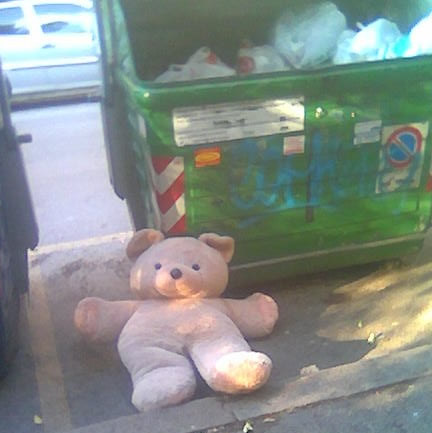
A "normal" picture which is a testimony tol madness and perversity of our society. Since when kids throw their toys into garbage at the first whim, and since when their parents consider it to be a sane behaviour?..
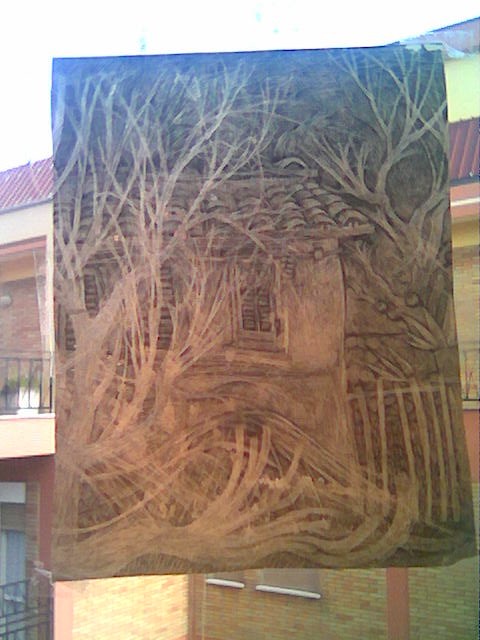
An "anti-dust"window shade etched with a pin on a piece of coloured plastic found in the garbage.

The effect which drawing with a pin on a piece of plastic gives is that of an ancient etching. Only in this case besides being an artwork, the drawing has a function- it is a perfect window shade-it is llight, it does not collect dust, it is cheap to produce, and inspite of being cheap, it looks sofisticated. The only difference here is that one looks through the drawing rather than hanging it on the wall and looking at it.

Here is another example of a low cost "stain glass"window shade-
a light shield made of dry autumn leafs glued upon each other. It is rather
fragile, but it costs nothing and the prime material is available in abundance
every fall.

This is a cofee-table and at the same time a lamp.
It is made out of a piece of plastic with autumn leafs glue to it inside.
The more scratched and damaged is the piece of plastic, the better is
the final effect. The lamp looks"antique", not old , and scratches somehow
go together with the autumn theme...while the material destined to become
scrap is turned into a beautiful object.

A box taken from a supermarket and decorated with old autumn leafs can make a very nice vase. Inside a plastic bottle with water is placed, and the overall effect is pleasant, though the costs are "o", and the production method is very simple.
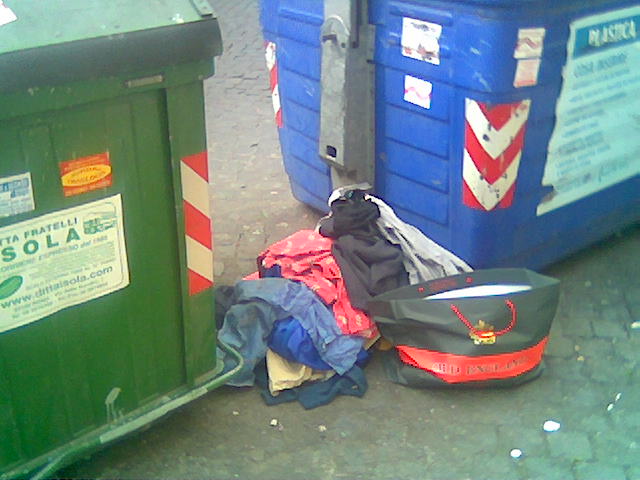
Gaqrbage containers are full of perfectly good objects which could, and should be used by those who need them. I would propose to modify them by creating on every street a small artisan's atelie, where at a very modest cost the thrown away objetcs could be modified to fit the needs and the taste of the new owner. 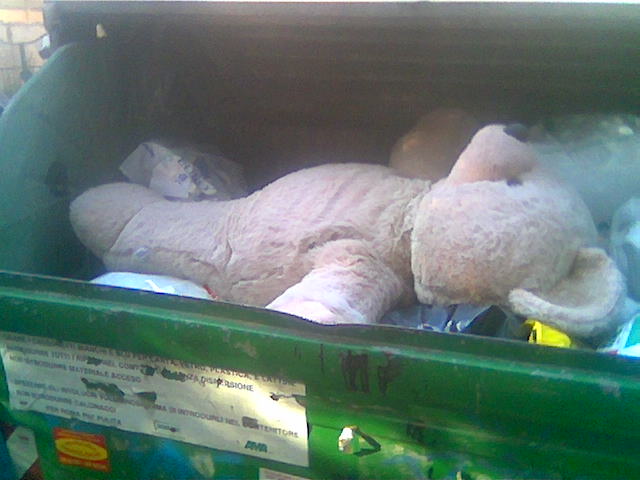
What's wrong with this toy except that it has been thrown into garbage?
Even beautiful stains on the ancient walls of Rome should not be waisted-they should be considered hints for fantastic designs, already there, which have to be "developed"like a photograph.Least of all should they be covered with even paint, as it is customary to do today.
My shoes, made out of bits and pieces of old shoes, happen to be very fashionable today. The only difference with the ones I see at the market is that my shoes have a story to tell, they are handmade and 100 per cent personal.
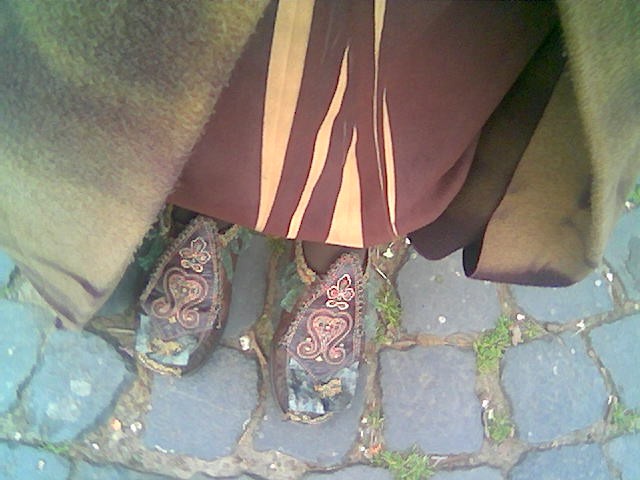
Proposal for a Mall-upon the Dump
Decades of regional and local recycling programs have had only a limited effect on the constantly escalating problem of waste disposal. Our garbage continues to pile up at an exponential rate, while citizen enthusiasm for recycling first waxes, then wanes.
Many once-thriving municipal efforts are shutting down, as manufacturing trends make large scale re-use of one or another waste category no longer economically profitable. Industry, meanwhile, seems obsessed with inventing new forms of throw-away products or product packaging, from computer monitors, ball pens and use-once-and-pitch razors, to the ubiquitous shrink-wrap plastic product container.
The flood of junk is constantly rising, constantly cresting at new heights. The recycling movement can't keep up-if in fact it ever did have a chance, in its original form, of stemming the rising tide of noxious stuff that threatens to overwhelm us and our children. Our environmental Maginot Line has long been breached, and the blue-box brigades thrown in to drive the enemy back are losing.
The recycling movement needs more than a shot in the arm. It needs a complete re-think, a renewal not only of its basic values, but of the framework within which it operates. Technological fixes won't be enough. What is required is a fresh way of thinking. We need a new strategy, a new starting point. A frame of mind
There are some 350 million people in Canada and the United States who, if they ever found themselves of like mind, could steamroller over even the most entrenched, well-financed corporate or financial special interest group like a political tsunami, engulfing all and turning our everyday world on its head.
All that's needed is a point of agreement, of understanding, and confidence that what we might attempt could actually work in the practical, everyday world where we live--in short, a frame of mind. The earliest recycling efforts were the fruit of such an understanding, an offshoot of the general environmental awareness of the 1960s and early 70's. Millions of people suddenly realized we were fouling our own nest, and putting our own and our children=s futures in danger. A partial solution to a major source of that foulness Cour garbage--presented itself: sort our refuse into categories, and find ways for large-scale industry to use each category as raw material for manufacturing.
Municipal governments and corporate North America, pressured by public opinion, set up programs, some of which, for awhile, worked. But the basic approach was flawed. It depended on large-scale industry to absorb our junk, while our own efforts were limited to merely rough-sorting A stuff at the curb, for fleets of trucks to pick up and haul away. And the sorting was a bother. It took time, interrupting whatever else we were doing. It was a civic duty that had to be performed, rather than something people would want to do for its own sake. Meanwhile industry, always evolving, always looking for ways to cut overhead, kept finding other sources of raw material, or cheaper sources, or new markets that didn't want products made from this or that substance. Specialists,engineers, scientists, accountants had to get involved, trying to keep up with the changes, trying to adapt what we put in the blue boxes to fit the profit and loss columns of corporations ledger books.
Feasibility studies had to be done, long-term projections made, business and marketing plans debated and developed by people with university degrees in such subjects. People, ordinary folks like you and I, weren't making the decisions. All we were doing was standing there at the curb, mechanically dropping bottles into one bin, plastic into another, paper into a third, while glancing at our watches to see if we had time for this bothersome rubbish-day-morning chore before going to work at the office or plant.
There is still a place for such recycling, of course. It does succeed in at least getting rid of part of our waste. But it isn't enough. And living lightly on the surface of our mother earth shouldn't be a mere chore. It should be a joy.
Personal choices
Imagine another scenario, one in which people find uses for the garbage they produce on their own, discovering answers to the problem within their own individual families and daily rounds. Rather than hauling tons of laboriously sorted glass or plastic from hundreds or thousands of homes to central gathering points, from whence fleets of trucks can carry it off to large-scale conversion complexes and manufacturing plants, individual items could be recycled at source, one-by-one, in our homes, before they even get to a rubbish dump. Instead of depending on specialists, on the kinds of experts who are required to plan mass-scale projects, thousands of home owners could come up with thousands of personal choices, with a myriad mini-solutions that fit their personal needs and preferences-collectively solving the problem of trash by converting it into something new before it becomes trash.
Take, for example, the common rubber tire. Anyone who owns an automobile, ATV, truck, tractor or other vehicle sooner or later ends up with worn tires on their hands. On a mass scale, some industries may be able to recycle them, but most often they end up in huge piles at some landfill, where eventually they may catch fire, burning for days and spewing out vast clouds of caustic fumes that blanket whole cities.
In Africa, there is no such problem. Cobblers snatch up worn auto tires, clamp them onto simple forms and cut them with a knife into the shape of the human footCrecycling them as durable, long wearing sandals. European and American tourists visiting Kenya's coastal resorts snap them up, first to wear at the beach, then to take home as souvenirs of their exotic vacation. African vendors display them in rows at the side of the road, where passers-by can try them on before buying. Other enterprising artisans weave tire strips into a kind of waterproof rubber thatch, for use in roofing sheds, garages and other outbuildings.
In Canada, Agarbage artist Carolyn Butts takes old tires and turns them into useful or simply decorative art objects. She creates mirrors, picture frames, table tops, wall coverings, every conceivable kind of object, each with its own use and unique aesthetic beauty. Her creations have been exhibited in galleries, and grace the homes of hundreds of people in eastern Ontario.
Or consider the flimsy, white plastic bag, which supermarket check-out people seem to delight in distributing, separating each grocery item into its own, private plastic sack. We carry dozens of them away with us each time we shop, cluttering up our homes and filling our waste baskets. They blow over the land in every city, like so many lifeless tumbleweeds, catching in trees and bushes, clumping together in corners and crannies. Even bags made of photo-sensitive plastics designed to deteriorate in sunlight create a problem, packed under heaps in landfills where the sun's rays can't strike them directly. Why should they be used only once, to carry a few tomatoes or some tiny piece of hardware from store to home, and then become an insoluble waste problem?
In Italy, designers turn them into decorative window coverings, piecing dozens of bags together, with colorful pictures superimposed, to create an effect not unlike the stained-glass windows in churches. Other designers have used them as fabric to make high-fashion, futuristic clothing. For several years, there has been an important fashion movement in England which uses such techniques. In the U.S., used furniture frequently ends up at Goodwill Industries or the Salvation Army thrift store, where it is painstakingly restored to something close to its original state by labor-intensive sanding, re-staining and varnishing.
A family could more easily take a cigarette-burned coffee table and use its very defects as part of its new decor, burning out many more cigarette holes and connecting them with lines to create a modern design. . Rather than trying to wipe out the effects of time by costly, sophisticated, time-consuming techniques to make an object look as it did before, people could see that objects have lives of their own, with all the scratched and burned consequences on their Askin. The key to restoring an old bed or chair would be not to erase, but to emphasize the beauty of time's scratches, smiling at defects and even making a joke around them, so that the restored object might make everyone laugh.
Finding second or third uses for surplus items or packaging is nothing new. People have been doing it for centuries. Empty tea tins grace the workshop shelves of every home handyman, filled now with screws, nuts and bolts instead of with tea. The upturned butt ends of glass bottles have been used as paving or as Aglass brick wall windows. The backs of used envelopes have provided a surface for jotting down countless shopping, laundry and Ato-do lists. The idea is as old as our species. Somewhere in the Kalahari, a traditionally-living Bushman is even now recycling a broken spear point for new use as an awl or punch.
The number of possible new uses for a given waste object is as varied as the number of human minds that decide to concentrate on the problem--in short, infinite. All that's needed is the mental habit of looking for such uses, the frame of mind that sees every existing thing as part of a continuum, constantly being recycled into something new: seed to plant, plant to food, food to animal bodies, bodies dispersed into the elements that nourish seeds and plants, completing the circle.
Everything in nature works that way, from the planet-wide hydrological cycle to the oxygen/carbon dioxide budget that allows plants and animals to provide each other with their own essential breath of life. Why shouldn't our society work that way, in terms of the materials and objects we depend on in our daily lives? Learning to see. Of course, not everybody has the imagination to come up with hundreds of ways to recycle garbage, nor the expertise to make sure new uses are appropriate or even safe.
Creativity may be innate in the human spirit, but it sometimes needs a boost, or an occasional guiding hand to realize its full potential. Here is where a series or chain of Recycling Malls could come in, taking the current concept of the strip mall or shopping center and converting it from a mere commercial eyesore, pumping out an unending stream of brand-new, more or less useless and unnecessary consumer products each with its own shrink-wrap plastic packaging, and each, under the concept of planned obsolescence, deliberately designed to break down or be used up in the shortest time possible to a place where local families could find shops selling converted, recycled items, materials-gathering points where local artisans could obtain the ingredients for everything from garbage art to furniture components, meeting places where people could take courses in innovative crafts or do-it-yourself home handyman how-to projects that make use of surplus items, or repair shops where skilled technicians could repair or re-assemble our used or damaged goods.
The local mall could be transformed, from a place for mere passive shopping or wasteful consumerism to a scene of creativity, invention and human interaction, a center where the recycler's boring, repetitive civic duty would be replaced by the excitement of experimentation and the pleasure of socializing with fellow members of the community.
Of course, such places couldn't spring out of thin air. Our present society isn't geared that way, and the ordinary person's mentality isn't prepared for it. A series of pilot projects must be instituted, inspired by a brain trust of forward-looking engineers, artists and innovators, who can generate and test ideas, then introduce those that work to a gradually-expanding network at local franchise level. Colonel Sanders started with one successful restaurant, proved his concept there, then branched out, eventually creating a myriad Kentucky Fried Chicken outlets. One prototype Recycling Mall could do the same, testing new concepts, proving their practicality, then multiplying them through national networks. Local centers would in turn come up with their own successful strategies, passing them back to the head office for transmission to others in the chain in a two-way traffic that continually renews itself.
Creativity like this unlike our present recycling efforts might have a real chance of keeping up with, or even pulling ahead of the innovations of large-scale corporate industry. Such ideas are not mere pipe dreams. I've personally implemented popular recycling programs at the local level in Europe and seen them succeed. As director of the oldest Sicilian regional carnival, held annually at Termini Imerese, I taught children from the entire city how to make costumes from plastic bags, old wrappings, etc. taken from their families garbage Outfitting children for this annual cultural event is normally a major financial strain for hundreds of ordinary working-class people, who feel obligated to spend significant sums on elaborate costumes to keep up with the Joneses.
In this region, most families have three or four children, while only the father is working. With a high local unemployment rate, sometimes even the father has no income. By creating a carnival atmosphere and original costumes from trash, instead of buying things in stores, we helped parents resolve a real socio-economic difficulty. I taught children to make their own carnival costumes as if it were part of a game. They loved it, discovering a new source of fun, and it cost the parents nothing. In the fishing port of Porticello, while the grownups were working in drydock building or repairing their traditional boats, I held garbage art seminars with the children. After, we decorated all the fishermen's boats with the works produced by their kids, for a waterfront parade that made the fleet of this little town stand out proudly from the drab craft of their neighbors. I conducted other recycling seminars at the Lingotto Fair in Torino and in front of the Winter Palace in St. Petersburgh, in Russia (see photos on my website, at www.sorridente.org).
Everywhere I encountered enthusiasm and interest, with people seeing the recycling project not as a humdrum bother or duty, but a fresh, exciting event. Unfortunately, without consistent, year-to-year support from some guiding organization or network, these isolated local programs tend to peter out and be forgotten. To survive and thrive, they need to be connected to a wider vision, an overall movement of which the individual festival or project is only one of many events, all stemming from the same basic philosophy.
What's needed.
To sum up, what is needed is a broad, national or regional program, supported by a consistent overall philosophy and inspired by the creativity of innovators from science, the arts, education and industry. An initial core group should be set up to create and test recycling prototypes and pilot projects, and to serve as technical advisors. Once a prototype has been tested and shown to be practical, it can then be introduced to interested community groups who can implement similar projects at their own local level, or develop variations on the same theme that take into account local conditions and resources. Ideas developed locally can then be circulated back up the ladder, inspiring other groups, including the original core groups at regional or national level. Eventually, individual projects would merge with each other, evolving into entire local complexes.
Recycling Malls with retail shops, demonstration and training centers, materials drop-off and sorting points where families could find spare parts for their own repair projects, and communication connections with other centers around a city, state or province. Member newsletters and websites could report on new ideas and trends, providing continuing updates and inspiration. And such centers would provide local jobs, for article restorers and repairmen and women, for people who know how to sew or work leather to recycle clothing and shoes, for woodworkers to restore or re-design furniture, welders, glass blowers or pipefitters who can create products, or advise customers on how to create their own.
The malls would create employment for teachers, instructors and group animators, for retail salespeople and store administrators to sell, trade or barter rebuilt, reconstituted or entirely reinvented products.
A Recycling Mall might support as many jobs as a conventional shopping mall, keeping those jobs in the community where they are needed, rather than exporting them to some Third World country whose workers are paid slave wages to turn out cookie-cutter widgets for a soulless multinational corporation. As such centers spread, becoming visible in communities across the continent, they would inevitably raise public awareness and begin to create a new consciousness among the general population, one that regarded it as normal not to waste, but to be inventive instead.
The overall effects of such a program would include: 1) a drastic reduction of the volume of garbage; 2) creation of new jobs in local communities; 3) positive publicity for participating communities; 4) tourist attractions (local fairs, carnivals, etc.); 5) environmental education of the population; 6) a healthier physical and cultural environment.
The rubbish problem would be solved and continually re-solved at its source, inside the human mind.